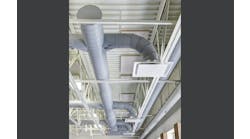Most educators and school designers believe that the quality of a learning environment affects how well students perform.
Some aspects of a learning space — size of a classroom, number of desks, the amount of textbooks and other materials — are easy to observe. But other conditions — air quality, acoustics, temperature — are less obvious to the naked eye, and undetected deficiencies can create health problems.
“Good indoor air quality is essential for teacher and student health,” the EPA says. “Good design also produces more comfortable environments with proper lighting, air temperature, humidity and noise levels. This reduces distractions and creates environments where students and teachers can see clearly, hear accurately, and not feel too warm or too cold.”
Many states have design manuals that provide guidance for providing good indoor environmental quality in schools. Earlier this year, New Jersey School Construction Corporation released its 21st Century Schools Design Manual to help the state's school systems build high-performance facilities.
A key to good indoor air quality is a heating and cooling system that provides sufficient ventilation.
“The entire system should be ‘right-sized’ (and seek) to reduce pollution sources while making use of appropriate technology to provide the optimum level of ventilation in the most energy- and cost-efficient manner possible,” the manual says.
Another factor in healthful air quality is an energy-efficient building envelope (walls, roofs, floors and windows). “The more efficient the building envelope, the less the HVAC system will have to work and the smaller (and less expensive) it can be,” the manual says.
To optimize the building envelope, planners should use an integrated design approach “that considers how all the components of the envelope interact with one another,” the manual recommends. “The benefits on an energy-efficient building envelope may be wasted if the HVAC equipment is not sized to take advantage of it,” the manual warns.
Other recommendations in the manual:
-
Regularly inspect and maintain a ventilation system so it operates as designed.
-
The building design should minimize water vapor condensation, especially on walls, the underside of roof decks, and around pipes and ducts.
-
Paints and coatings, adhesives and sealants, composite wood, and carpet and hard-surface flooring should consist of low-emitting materials.
-
Cleaning, pest management and maintenance programs should minimize the use of toxic materials.
To reduce walkers from tracking pollutants into a facility, schools should have a permanent walk-off mat or grate system of at least six feet. Spaces that have equipment that may produce hazardous gases or chemicals should have dedicated exhaust systems.
NOTABLE
30 to 40
Percentage savings in utility costs that school districts can realize if newly constructed facilities are built with high-performance design and sustainability concepts.
450
In cubic feet per minute, the amount of outside air required to adequately ventilate a classroom of 30 occupants.
Source: U.S. Environmental Protection Agency, IAQ Design Tools for Schools

